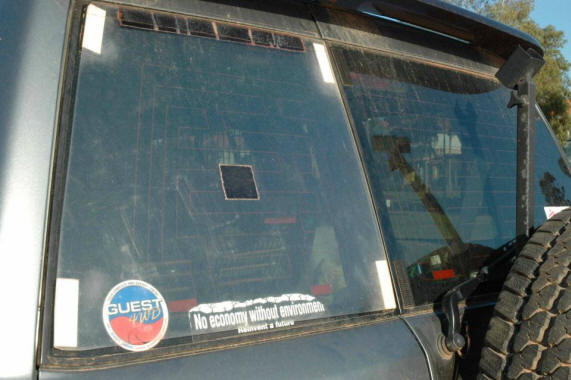|
DIY rear window
protector
removable
polycarbonate screen for GU3 patrol

Malcolm's
GU3 Patrol's DIY rear window protector has been made from laser cut 2mm
polycarbonate. The above photo shows the protector installed to the
left hand rear barn door only.
The
polycarbonate has been installed using
3M Reclosable Industrial Fastening Systems This system has
far superior interlocking action than velcro. The self adhesive is
also of a better quality, coping with heat & vibration.
You can also
see on the left hand window the location of the Velcro loop strips which
provide padding. The Velcro strips were actually left over from my
first (unsatisfactory) attempt at attaching the protectors. I would
have replaced them with more elegant self-adhesive neoprene but I found
the Velcro adhesive very tedious to remove and I'm lazy!
The performance
of the rear window protector has been very satisfactory over more than 18,000km on my last 3 month
trip.
The polycarbonate sheet costs around $50 for both windows, plus the 3M
dual locks at about $8 per pair. Laser cutting was done by a friend,
however I would estimate that the whole job including laser cutting
would cost around $100 to $150. Much less than a replacement window
and bit less than commercially available equivalents.
Below you will find links to two dxf files which are needed if you want
to have the sheets professionally cut to match a GU3 Patrol's rear glass
using a numerically controlled cutter or to computer plot them as
templates. These are what you email the people doing the cutting to
feed into the laser cutting machine. The dxf files were created using
AutoCAD and are the ones I used to produce the protectors for my GU3
Patrol so I know they work and I checked them before posting them to the
tech tips pages.
The dxf files can be used without modification as input to Computer
Drafting software such as AutoCAD to allow you to plot templates for
accurate transfer to the polycarbonate, but note that if you use
drafting software other than AutoCAD (such as Microsoft Visio) you may
have scaling issues to contend with and must carefully double check all
dimensions prior to cutting!
If you are having them laser cut, I recommend double checking the
dimensions with the people doing the cutting - you never know with
software! The maximum (bottom edge) width of the LH panel should be
560mm and the RH one 826 mm. The maximum (centre edge) height of both
is 477mm. A dimensional tolerance of around +/- 1mm shouldn't cause a
problem."
The alternative of manually cutting from a template drawn on
the polycarbonate backing paper is obviously cheaper but labour
intensive and can be hard work to obtain a clean accurate finish.
dxf file for lefthand Nissan Patrol GU3 rear
window
dxf file for righthand Nissan Patrol GU3 rear
window
Note:
Please make sure the rear window protector is positively connected to
the vehicles rear window. The driver has a 'duty of care' to other road
users with the operation of a vehicle in a safe manner. You must not
place others at risk with the protector coming loose.
thanks to Malcolm Robins
for sharing this information.
april 2008
|